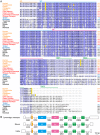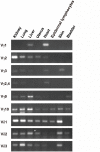The SKINT1-like gene is inactivated in hominoids but not in all primate species: implications for the origin of dendritic epidermal T cells
- PMID: 25830554
- PMCID: PMC4382165
- DOI: 10.1371/journal.pone.0123258
The SKINT1-like gene is inactivated in hominoids but not in all primate species: implications for the origin of dendritic epidermal T cells
Abstract
Dendritic epidermal T cells, which express an invariant Vγ5Vδ1 T-cell receptor and account for 95% of all resident T cells in the mouse epidermis, play a critical role in skin immune surveillance. These γδ T cells are generated by positive selection in the fetal thymus, after which they migrate to the skin. The development of dendritic epidermal T cells is critically dependent on the Skint1 gene expressed specifically in keratinocytes and thymic epithelial cells, suggesting an indispensable role for Skint1 in the selection machinery for specific intraepithelial lymphocytes. Phylogenetically, rodents have functional SKINT1 molecules, but humans and chimpanzees have a SKINT1-like (SKINT1L) gene with multiple inactivating mutations. In the present study, we analyzed SKINT1L sequences in representative primate species and found that all hominoid species have a common inactivating mutation, but that Old World monkeys such as olive baboons, green monkeys, cynomolgus macaques and rhesus macaques have apparently functional SKINT1L sequences, indicating that SKINT1L was inactivated in a common ancestor of hominoids. Interestingly, the epidermis of cynomolgus macaques contained a population of dendritic-shaped γδ T cells expressing a semi-invariant Vγ10/Vδ1 T-cell receptor. However, this population of macaque T cells differed from rodent dendritic epidermal T cells in that their Vγ10/Vδ1 T-cell receptors displayed junctional diversity and expression of Vγ10 was not epidermis-specific. Therefore, macaques do not appear to have rodent-type dendritic epidermal T cells despite having apparently functional SKINT1L. Comprehensive bioinformatics analysis indicates that SKINT1L emerged in an ancestor of placental mammals but was inactivated or lost multiple times in mammalian evolution and that Skint1 arose by gene duplication in a rodent lineage, suggesting that authentic dendritic epidermal T cells are presumably unique to rodents.
Conflict of interest statement
Figures






References
-
- Allison JP, Havran WL. The immunobiology of T cells with invariant γδ antigen receptors. Annu Rev Immunol. 1991; 9: 679–705. - PubMed
-
- Hayday AC. γδ cells: a right time and a right place for a conserved third way of protection. Annu Rev Immunol. 2000; 18: 975–1026. - PubMed
-
- Itohara S, Farr AG, Lafaille JJ, Bonneville M, Takagaki Y, Haas W, et al. Homing of a γδ thymocyte subset with homogeneous T-cell receptors to mucosal epithelia. Nature. 1990; 343: 754–757. - PubMed
Publication types
MeSH terms
Associated data
- Actions
LinkOut - more resources
Full Text Sources
Other Literature Sources
Molecular Biology Databases

